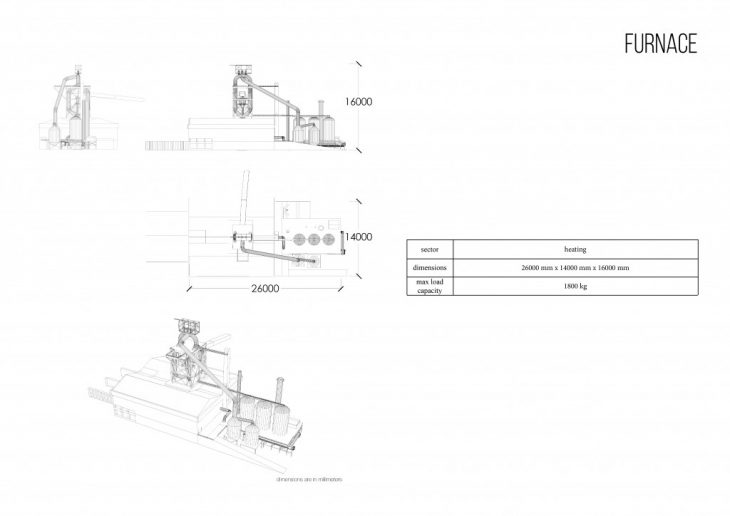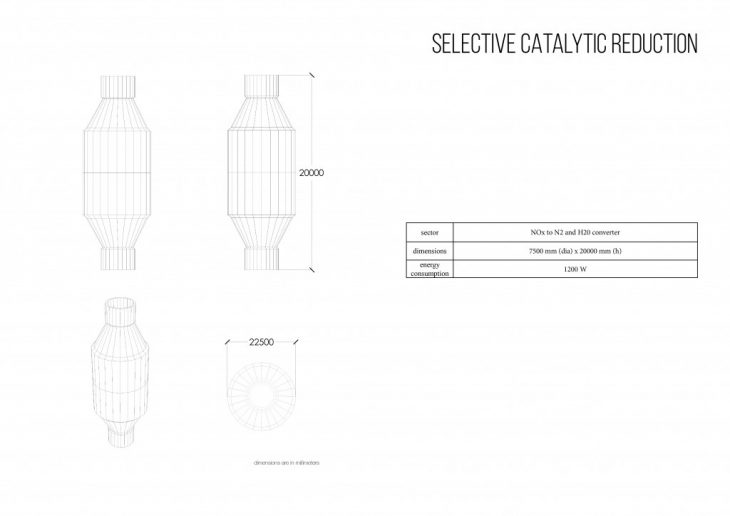
Thesis Studio – The City in the Age of Hyperobjects. A search of new Forms of Architectures for our City
Student – Camilla Franchini
Faculty – Peter Trummer
What is Humanless Architecture?
Humanless Architecture refers to an automated system of production, of which the urban layout is designed for the machines themselves. The inbound, production, packaging and delivery is controlled by the machines.
Industrial automation fulfills the aim of the company by allowing the company to run a manufacturing plant for 24 hours in a day 7 days in a week and 365 days a year. This leads to a significant improvement in the productivity of the company. Automation alleviates the error associated with a human being. Further, unlike human beings, robots do not involve any fatigue, which results in products with uniform quality manufactured at different times. Adding a new task in the assembly line requires training with a human operator, however, robots can be programmed to do any task. This makes the manufacturing process more flexible. Adding automated data collection, can allow you to collect key production information, improve data accuracy, and reduce your data collection costs. This provides you with the facts to make the right decisions when it comes to reducing waste and improving your processes. Industrial automation can make the production line safe for the employees by deploying robots to handle hazardous conditions.
Industrial automation is a fact. It improves the quality and quantity of the outcome.
Context
The actual Earth […] now contains throughout its circumference a thin layer of radioactive materials, deposited since 1945. […] The deposition of this layer marks a decisive geological moment in the Anthropocene, a geological time marked by the decisive human “terraforming” of Earth as such.
Timothy Morton, Hyperobjects
The Anthropocene Era is an uncontestable fact; the results surround us, every day, in everything we do, everywhere we look. Ever since humankind existed, humans have always put themselves at the center of their interests, resulting in changing the planet we live on, irreversibly. It is time to change.
Architecture was born from the human need of a protective habitat, and since then, it has always been for humans, conceived in human scale before any other. What if human scale was not the only scale we could apply to it? What if now it was time to shift to another type of scale?
My generation was the first generation to grow up with technology, in 25 years of my existence, technology has developed, and reached the point of changing our lives completely. What used to be done and thought by man, now it’s being processed and done by machines. The role of machines will never decrease; it can only become more influential in the world we live in. Studies are, in fact, being made, all over the world, to make machines work like humans, to change our lifestyles by making them produce for us what we are now producing ourselves, supposedly, to make our lives easier and more enjoyable.
Taking in considerations these two main factors, I am proposing as project area a seaside quarter of the city of Naples, in Italy. Italy is, in fact, one of the oldest countries in Europe, it owns one of the most important architectural heritage in the world, filled with history, cultures, styles.
The inhabitants found themselves so attached to its past, that became unwilling to discover and understand contemporary problems, and therefore to try and solve them. The challenge becomes, therefore, designing in great contrast with the existing context and, most of all, the local mentality of the people.
My proposal is to design a humanless productive system entirely controlled by machines. A territory that collects the most progressive innovation, not based on roads and infrastructure, but based on the needs of the machines to produce, collect and distribute, designed in a self-sufficient way. The idea behind the project is not to demand to solve a problem, but it aims to present the city into a different perspective, which is not human-centered anymore, but machine-centered. The project will be an attempt of moving as far as possible from tradition, including the historical way of approaching to urban design, by presenting a design that creates such a great contrast with the tradition, that would appear as something unimaginable by the population.
Methodology
The thesis development started with a research on existing automated industries around the world. Different typologies were selected and analysed according to dimensions, type of production, outcome, energy consumption, and most of all, machinery used.
Together with the research on the buildings, a research on the robotics and machinery used was done, with the aim of understanding the task, physical dimensions, footprint, type of movement.
The research was then summarized in a catalogue of 6 factories their machines. The factories, with their structural internal layout, were also 3D printed in 1:2000 scale.
Case Studies
Mountpark Airport City
Gigafactory
Amager Bakke
Shenzhen East
Techno Farm
Impossible Foods
































Hypothesis
Suburban abandoned areas can become the new industrial neighborhoods for the contemporary cities, by designing them as humanless self-sufficient productive systems.
Next Term Plan
The first step in the next term will be to 3D print the different machines, to create a tangible catalogue to be used with the models of the industries.
The collected data and the 3D prints will be used to design the urban layout of the system, according to the footprint, movement, supply needs of the machines. The system will be initially developed in plan, with a clear division of function in terms of production typology.
The aim is to design a system that works in terms of self production of energy, production, packaging and transport.
